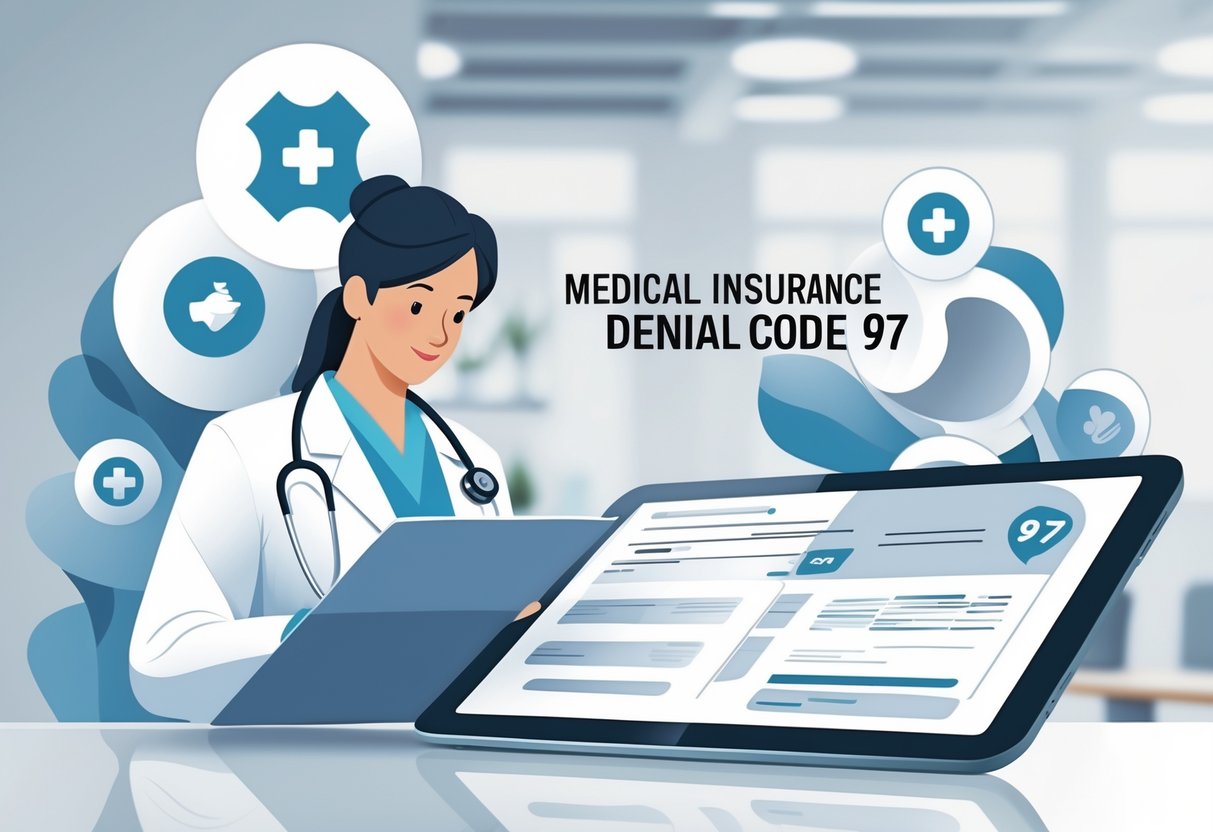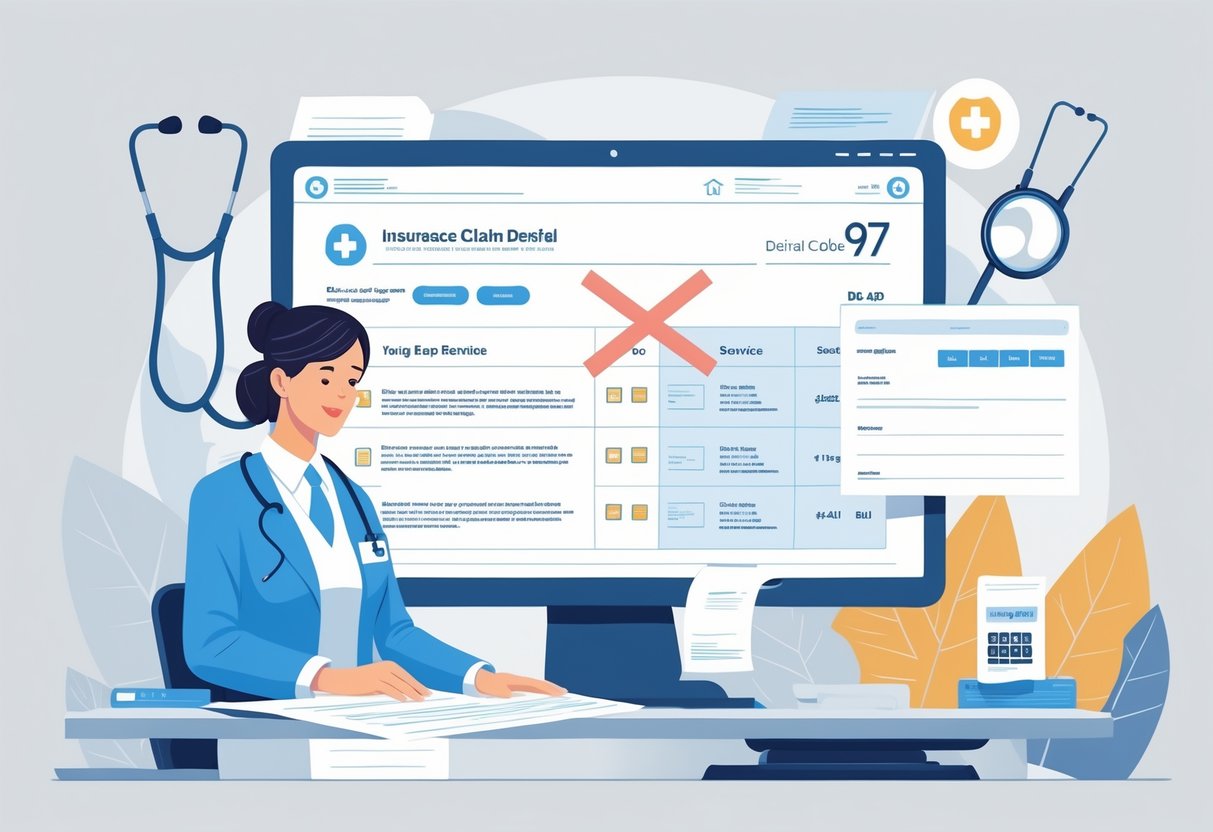Denial code 97 means that the payment for a service you billed is already covered by another service that was paid earlier. This code tells you not to expect separate payment because the benefit is included in the payment for a related procedure.
When you see denial code 97, it usually means the insurance company thinks the services overlap or are part of the same treatment. Knowing this can help you avoid billing the same work twice and improve how you submit claims.
Understanding denial code 97 can save you time and prevent confusion when dealing with insurance payments. You’ll learn how to recognize and handle these denials to keep your billing process smooth.
Understanding Denial Code 97

Denial Code 97 means the payment for the service you billed is included in the payment for another service already paid. This code helps avoid double payment for related services.
Definition and Explanation
Denial Code 97 states that the benefit for your billed service is part of the payment for another procedure already processed. This means your claim may be denied because that service was bundled with another paid service.
The denial prevents duplicate payments when two or more procedures are related or happen at the same time. It ensures that you do not get paid twice for services that are considered part of one main service.
You need to review your billing to verify if the denied service was properly included as part of another service. Sometimes, this denial happens when modifiers or correct coding are missing.
Common Scenarios for Denial Code 97
You often see Denial Code 97 when billing for a routine service included in a larger procedure. For example, office visits may already cover minor procedures done during that visit.
It can also occur when a test is part of a procedure package or when two procedures overlap in time. Another example is when lab work is included in the surgery payment.
To avoid this denial, check if the service you billed is separately payable or always bundled. Use modifiers carefully to indicate when a service is not included. Documentation helps support the need for separate payment.
Causes and Triggers of Denial Code 97

Denial Code 97 happens when a service you billed is already covered under another payment. This can occur due to how services are grouped, mistakes in coding and billing, or specific rules from the insurance payer. Understanding these reasons helps you avoid repeated denials.
Bundled Services and Procedures
You might see Denial Code 97 when your claim includes a service already paid for as part of a larger procedure. For example, if you bill a minor procedure separately that is included in the payment for a bigger surgery, the payer will deny it.
Bundles are common in surgery, lab tests, and office visits. Many payers group related services together and pay one combined amount. You should review payer guidelines carefully to know which procedures are bundled.
If you bill for something already covered, the denial will state that the benefit is included in the payment for another service. To avoid this, don’t separately bill services that are part of a payer’s bundled set.
Coding and Billing Errors
Errors in coding or billing can trigger Denial Code 97. This happens if you use incorrect procedure codes or miss modifier use that would explain why a service should be paid separately.
For instance, a missing modifier that shows a service was different or distinct can cause denial. Also, duplicate charges for the same service can lead to this error.
Double-check your codes, use correct modifiers, and ensure services are not billed twice. Accurate coding reduces chances of rejection under this denial code.
Payer-Specific Payment Rules
Insurance companies have different rules about which services they include together for payment. What one payer bundles, another might pay separately. Denial Code 97 often appears because of these specific rules.
You need to review each payer’s policies. Some plans bundle services tightly and deny added claims for those, while others allow separate payment more often.
Check payer manuals and bulletins to understand what is considered bundled. Adjust your billing processes to match these rules to lower the risk of a Denial Code 97.
Impact on Reimbursement and Revenue Cycle Management
Denial code 97 affects how payments are processed and how billing is managed for your services. Understanding its effects can help you handle claims more efficiently and avoid surprises in your revenue flow.
Financial Implications for Healthcare Providers
When you receive denial code 97, it means the payment for the service you billed is included in another already paid service. This can lower your expected reimbursement because the insurer won’t pay twice for related work.
You may need to review your billing practices to ensure you don’t submit overlapping charges. Tracking bundled services closely helps prevent denied claims.
If denials happen often, your overall revenue could drop. You might spend extra time and money appealing denials or adjusting claims, which slows down your cash flow.
Patient Billing Outcomes
Denial code 97 usually means the patient won’t be billed again for the denied service. Since the insurer considers the payment part of another service, your patient’s financial responsibility does not increase.
This code helps avoid duplicate charges to patients, keeping their bills more predictable. However, it’s important you explain why some services show as denied to reduce confusion.
You still need to communicate clearly with patients about which services were paid and what is covered in your billing to maintain trust.
Strategies to Prevent Denial Code 97
You need to focus on precise coding and clear documentation to avoid this denial. Also, submitting your claims accurately helps reduce errors that cause the problem.
Accurate Coding and Documentation
Make sure your coding matches the services provided without overlap. Use the correct procedure codes that do not duplicate payment for the same service already covered.
Document every service carefully. Note the exact treatments and procedures performed. Clear notes help explain why each service was necessary and separate from others.
Double-check codes for bundled services. If a payment includes multiple related procedures, do not bill them separately. Avoid using codes that are part of a package already paid.
Effective Claims Submission Practices
Review your claims before sending them to catch errors. Check if any service matches another already billed and paid.
Use billing software or tools that flag duplicate or bundled codes. This helps identify potential denial reasons before submission.
If you serve multiple providers, coordinate to avoid billing the same service twice under different names. Submit clean claims with complete, accurate data to speed up approval and minimize denials.
Appealing and Resolving Denial Code 97
You can challenge Denial Code 97 by carefully following specific steps. You will also need clear proof to support why the payment for the service should be separate from any other service already paid.
Steps to File an Appeal
First, review the explanation of benefits (EOB) or remittance advice to confirm the denial details. Make sure the service you billed is different from or not included in another service that was paid.
Next, contact the payer to understand their reason for the denial. Some payers have specific forms or online systems for appeals.
When filing your appeal, include:
- A clear statement that you disagree with the denial
- The denied claim number and service details
- Any relevant codes or charges
Meet any deadlines for submission. Late appeals are usually rejected without review.
Supporting Documentation and Justification
You must provide proof that the service is not bundled with another already paid service. This proof can include:
- Medical records showing distinct procedures or treatments
- Notes from the healthcare provider explaining the need for both services
- Official coding guidelines or payer policy statements supporting separate payment
Use clear and factual language in your justification. Avoid opinions and focus on how the codes apply to your case.
Well-organized documentation improves your chance of a successful appeal. Include all relevant pages and avoid unnecessary information.
Frequently Asked Questions
You may face denial code 97 when a service you billed is already covered by payment for another service. Understanding reasons for denial, payment bundling, and the right documentation can help you manage these claims effectively.
How can I address a claim rejection due to denial code 97?
Review the services billed to check if one is included in another payment. Contact the payer to confirm bundling rules. If you believe the denial is wrong, gather supporting documentation and submit a corrected claim.
What are the common reasons for receiving denial code 97?
This denial usually occurs when two procedures are billed separately but one is part of the other’s payment. Sometimes, it happens due to overlapping services or payer policies that bundle payments.
What steps should be taken when payment for a service is bundled into another procedure’s payment?
Identify the primary procedure that includes the bundled service. Adjust your billing to avoid duplicate claims. If both services must be reported, use modifiers as allowed by payer rules.
How can a provider prevent future denials similar to code 97?
Check payer policies for bundled codes before billing. Train your staff on correct billing practices. Use coding tools to verify if services are separate or included in other payments.
What documentation is necessary to dispute a denial code 97 claim?
Include detailed notes explaining why the service should be paid separately. Provide medical records or reports showing distinct service delivery. Attach any payer instructions supporting the claim.
In what scenarios might denial code 97 be incorrectly applied to a claim?
The denial might be wrong if the two services are distinctly different and not bundled by the payer. Errors in claim submission or payer processing can also cause wrongful denial. Reviewing claim details helps identify mistakes.







